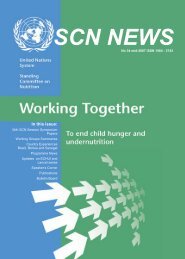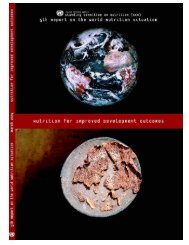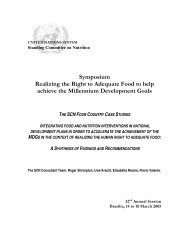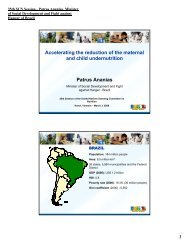Universal Salt Iodization (USI) - FTP Directory Listing
Universal Salt Iodization (USI) - FTP Directory Listing
Universal Salt Iodization (USI) - FTP Directory Listing
- No tags were found...
You also want an ePaper? Increase the reach of your titles
YUMPU automatically turns print PDFs into web optimized ePapers that Google loves.
60PROGRAMME NEWSwww.unsystem.org/scnThe study further suggested a step-wise reduction of the iodization standard since the retained iodine was above therecommended levels even after environmental exposure in retail and storage in bulk. The Food Nutrition and ResearchInstitute further studied the stability of iodine at the salt farm production and endorsed lowered iodine content standards(4). Recently, the country’s Bureau of Food and Drugs lowered the recommend standards of iodine levels of salt to 20-70 mg/kg across distribution channels (5). This will reduce the cost of iodization and encourage compliance amongmanufactures and traders. By Rayco-Solon P, Maramag CC, Solon JAA, Solon FS.Nutrition Center of the Philippines, Western Bicutan, Taguig City, Philippines www.ncp.org.ph(1) Department of Health. Republic Act No. 8172: An Act Promoting <strong>Salt</strong> <strong>Iodization</strong> Nationwide and for Related Purposes (ASIN Law)and its Implementing Rules and Regulations S. no. 1122 H. no. 45. Makati City: National Nutrition Council, 1996. Available online,accessed 18 December 2007. (2) Maramag CC, Tengco LW, Rayco-Solon P et al. Stability of iodine in iodized fresh and aged saltexposed in simulated market conditions. Food and Nutrition Bulletin, 2007. In press. (3) Department of Health. Revised ImplementingRules and Regulations of Republic Act No. 8172 “An Act Promoting <strong>Salt</strong> <strong>Iodization</strong> Nationwide and for Related Purposes. Availableonline, accessed 18 December 2007. (4) Saises MC, Capanzana MV, Garcia RG et al. Safety and stability of iodine in iodized salt atproduction level in selected salt farms in the Philippines. Abstract presented at the 33rd FNRI Seminar Series, 10-11 July 2007, Manila.(5) Department of Health. Bureau Circular No. 2007-009: Updated standards for iodine level of salts. Muntinlupa City: Bureau ofFood and Drugs, 2007.BrazilImpact of <strong>Salt</strong> <strong>Iodization</strong> in Brazil - Ministry of Health of BrazilIodine deficiency is a natural and permanent phenomenon widely spread throughout the world. People living in iodinedeficient areas are at risk of developing Iodine Deficiency Disorders (IDD), as mental retardation, deaf mutism, congenitalanomalies and goitre. Iodine deficiency also increases the cases of perinatal and infant mortality and risk of abortion.In Brazil, IDD was first classified as public health problem in 1950, when about 20% of population had goitre. At thesame time the Brazilian government has pursued <strong>Universal</strong> <strong>Salt</strong> <strong>Iodization</strong> (<strong>USI</strong>) in order to reduce the high prevalenceof IDD. Since then, the Ministry of Health has already conducted four surveys to evaluate the impact of this intervention,showing significant decrease in goitre prevalence (20,7% in 1955; 14,1% in 1974; 1,3% in 1984; and 1,4% in 2000).In order to sustain IDD elimination, the Brazilian government, in partnership with the salt industry, universities andNGOs, has recently reviewed the National Program of IDD Control, resulting in the publication of new technical and legaldocuments. In 2005, new legislation with the following official strategies to keep IDD elimination was published: monitoringof salt in industries; impact evaluation of salt iodization; updates on <strong>USI</strong> legislation; implementation of educationalactions and social mobilization on the importance of IDD and consumption of iodized salt.According to this legislation, Brazil must develop impact evaluation of salt iodization every three years. In 2008, Brazilwill conduct a survey to evaluate the impact of salt iodization in the entire country, involving analysis of urine and saltsamples of about 40,000 school-age children (6 to 14 years). The results are essential to evaluate if salt iodization offeredin Brazil is able to provide enough quantity of iodine to prevent and to control the IDD without risk of diseases associatedto excessive iodine consumption. Besides, the results will allow Brazil to update the international database systemsand receive the “International Certificate of Iodine Deficiency Disorders Elimination”.Contact: CGPAN, General-Coordination of the Food and Nutrition Policy, Ministry of Health of BrazilSEPN 511 C Bittar IV- 4º floor, Brasilia DF, Brazil, 70.750-543. cgpan@saude.gov.br www.saude.gov.br/nutricaoWHO/UNICEF Joint WHO/UNICEF Statement onReaching Optimal Iodine Nutrition in Pregnant and Lactating Women and Young ChildrenBased on new evidence and lessons learned within the last decade, it appears that the most susceptible groups -pregnant and lactating women, and children less than two years of age - might not be adequately covered by iodizedsalt where <strong>Universal</strong> <strong>Salt</strong> <strong>Iodization</strong> is not fully implemented. This situation may jeopardize the optimal braindevelopment of the fetus and young child. In order to address this issue, WHO convened a technical consultation on theprevention and control of iodine deficiency in pregnant and lactating women and in children less than two years of age.The consultation, held on 24-26 January 2005 in Geneva, Switzerland, made recommendations to ensure optimumiodine nutrition among these groups (1). As a follow-up to the meeting, and in order to provide programmatic guidance toimplement these recommendations within the country programme planning process, WHO and UNICEF held a jointmeeting on 15-16 November 2005 at UNICEF Headquarters, New York, USA.The statement is available online from www.who.int/nutrition1. WHO. Prevention and control of iodine deficiency in pregnant and lactating women and in children less than two years old. WorldHealth Organization. Geneva (In Press).SCN NEWS # 35 back to contents







